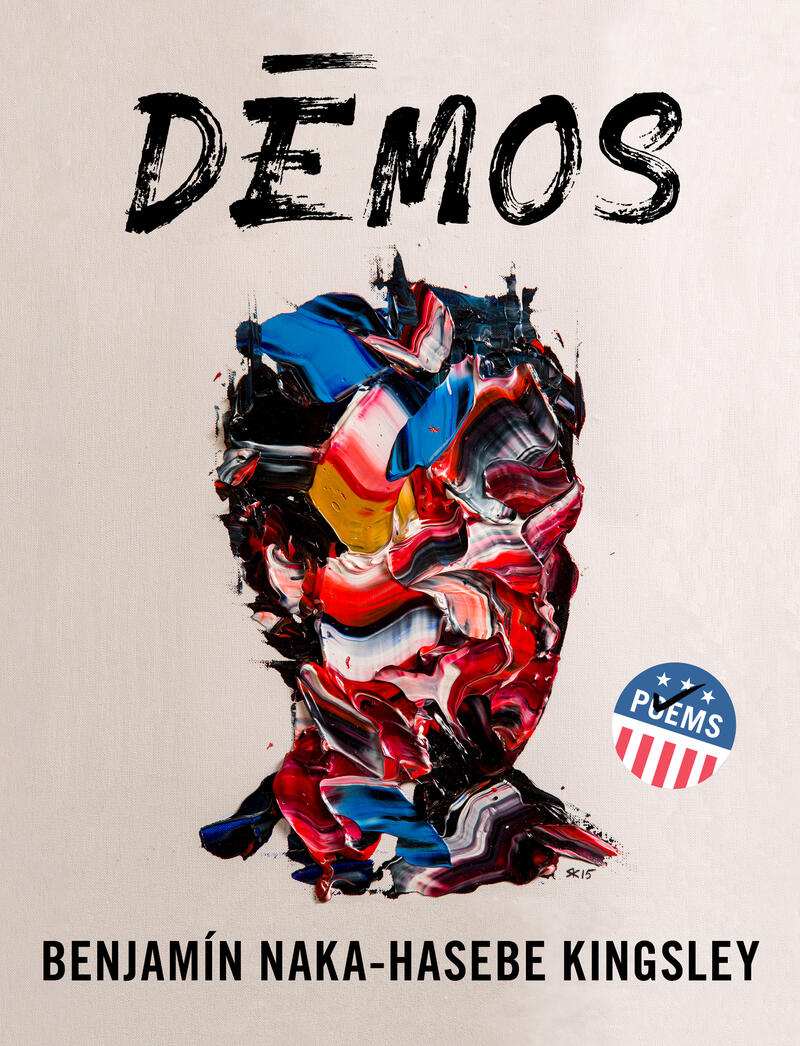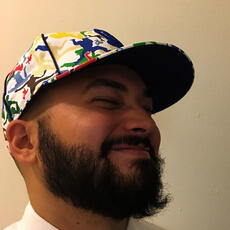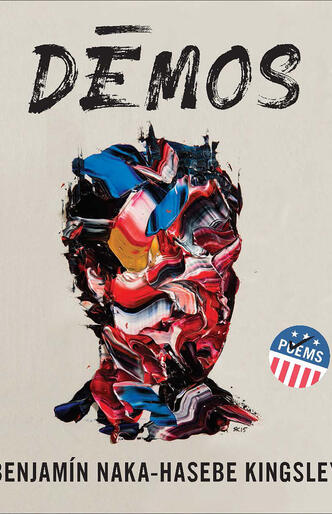5 Reasons to Teach This Book: Dēmos
Welcome, friends, to the latest installment of 5 Reasons to Teach This Book! In this interview series, we examine what we can learn from Milkweed’s titles by discussing our books with educators, authors, and booksellers. This month, we’re delighted to feature an incandescent conversation between Benjamín Naka-Hasebe Kingsley and Milkweed Fellow Tijqua Daiker. Read on to learn more about Kingsley’s upcoming poetry collection, Dēmos: An American Multitude, out in March!

Tijqua Daiker: I’m endlessly intrigued by the poems in this collection that appear in the form of Punnett squares. It speaks to the science of identity, which has such deep history within American colonialism. Could you expand upon how this form influenced your writing and/or, conversely, how you envision your writing working with this form?
Benjamín Naka-Hasebe Kingsley: In ninth grade Biology I had a homie—we must’ve been fourteen, not even—and while we’re going through all that genotype/zygote stuff (I says “stuff” because I got through high school by the absolute skin of my shovel-shaped, Native incisors, and am still very much making up for that mislaid literacy) the teacher is giving prompts like “fill out these squares with your family history: eye color, recessive, dominant, knuckle hair, yea, nay, etc,” and we kids start filling them out for ethnicity, which is hilariously apropos in its nearly two decade-ago ignorance, for we so wise in 2020—as if these cultural markers were some recessive trait you’d maybe or maybe not be born with, infused by—and I remember writing all four of my “races” outside those Punnet boxes—Onondaga, Cuban, Japanese, Appalachian—and fitting them together as if I’d be able to figure out why I was (why I was me), and my homie looks over at me and says, “You’re one fucked up Punnet Square.” That really stuck with me. A fucked up Punnet Square. I saw myself like that for a long time. I see myself like that right now. If my monitor goes black and becomes that smudged, electric mirror, I’m one fucked Punnet Square. That’s me. Because I have this intimate, or at least long-standing, relationship with a sterile, probabilistic diagram (easily misread as “problematic”)—as I am a kind of cross breeding experiment in and of myself—my goal in the poems was to remove more of the individual “me” and focus on the higher resolution “we,” à la “we the people” and what a crisscrossed American experiment might yield. I wanted to experiment, to turn that relationship on its ear. You put that all-too-famous (or way, way not famous enough) Phips Bounty Proclamation on one side of the Punnet; you put my people, our people, on the other; what do you get? The results aren’t as anodyne as eye color. They aren’t as neat as knuckle hair. Not tidy as can she roll her tongue, her “R’s?” When They are dominant, what do We inherit? Is revolution a recessive necessity? I hope these poems act as a macro lens overlaying the collection’s otherwise, hopefully high res, collection of unfolding intimacies.
TD: Perhaps it’s the adoptee in me, but I’ve always been a bit hyperaware of the space between perceptions of self. Dēmos engages with this space as its poems capture the multitudinous nature of self. America often proclaims itself a melting pot or a woven tapestry of identities. However, the phrase “fractured identity” also comes to mind. The difference between them, in my opinion, is the space between them. A ‘melting pot’ speaks more to a blurring of identities, whereas a tapestry is a nestling and understanding identity as fractured is a fragmentation. Which of these perceptions of self most resonates with you? Which did you draw upon most while creating Dēmos?
BNHK: This is a beautiful question and beautifully phrased. I’ve been teaching college students for a hot minute now, and especially, especially at the beginning—like ten years ago—students would always ask “where are you from,” which is to say what are you, what race are you, I used to get asked that outright a lot, we know the whole rigamarole by now—especially if you look remotely ethnically ambiguous (or even if you don’t). I get out ahead of that somewhat these days, but it initially led to some of the wildest classroom conversations. Do you remember when Scarlett Johansen—sorry if I’m spelling her name wrong here, but maybe it’s better to let my ignorance show—was slated to play Major Motoko in a late twenty-teens adaptation of Mamoru Oshii’s Ghost in the Shell? As a nineties kid, I grew up love, love, loving 1995’s Ghost in the Shell. Anyway, if you remember, the casting sparked a lot of conversations about cultural appropriation. Scarlett is white; she shouldn’t play a Japanese character; etc. Okay, now getting to the heart of your question: my class would of course say unanimously “Scarjo = no-go. They should cast someone who’s Japanese.” I’d say, could I (Ben) play Major Motoko? Am I ‘Japanese enough?’ My students would kind of ponder it for a second, and then almost everyone would say, “No!” I must’ve run this experiment in six different class that semester—I was adjuncting at the time on a 5/6 load, phew, P.S. everyone who teaches at an ununionized college/community college/jc rise up! At the time, I was also writing my first book Not Your Mama’s Melting Pot—it’s so appropriate that the title directly addresses the language of your question. So, my students would explain in one fashion or another that one quarter Japanese was not “Japanese enough” to fulfill that spatial requirement, that “Japanese enough” envisioned metric. I was too fractured. I was too blurred. I was too nested. My tapestry was too torn; there was too little fabric to weave whatever justice must be woven. It hurts. But, I get it. I know what it’s like to be too little to count as anything or even enough. I’d follow this line of logic, this classroom discussion, up with a little background on my Japanese heritage.
Excerpt from Dēmos:
Before Anything: Acknowledgement
ありがとうございます arigatō gozaimashita firstly to my obaasan—grandmother Matsume Hasebe—who taught me that if a tyrant’s narrative can be a well-formed prison, a poem can be a creature of protesting fire inside of that prison. Thank you for your father, Naka Hasebe, his fire, his poem that would put him behind the exactness of these very wooden bars. See the Warhorse Cry he wrote in defiance of an imperialist, Axis nation’s “Sun God”: Emperor Hirohito.

Matsume Hasebe (Jan 4, 1989 Tome Police Station) behind the same wooden bars that imprisoned her father in embattled WWII Japan.
The political prisoners greatly feared a fire, as they would surely burn alive inside their wooden cages—many of their homes had already burned, including my grandmother’s childhood home, in the great Fire Bombing of Tokyo, the single most destructive bombing raid in human history: such great American butchery that bomber pilots had to apply their oxygen masks to keep from vomiting as they were hit by the reek of burning flesh, charcoaled corpses, and clouds of civilian blood.
Long story short, my great grandfather Naka Hasebe writes this hybrid essay/poem about Emperor Hirohito’s famed horse—a real thinly veiled criticism of his people’s (Japan’s) then-God’s famed warhorse. My kin is imprisoned, beaten, etc. Later my grandmother flees to America, flees FDR’s West Coast internment, and ends up in super small-town Somerset (central), PA of all places. Fade to black. Okay, now here’s me. ¼ Japanese. Am I Japanese enough? “Class, am I Japanese enough now?” Pause. Pause. Pause. Oh, hell yeah, is the unanimous response. So, I only get to be what I am if I bleed for it? If those who came before me bled for it? Is trauma’s fruit really worth the platitudinal squeeze? We teach show; don’t tell. (I’m very glad this aphorism is falling out of fashion.) When creating Dēmos I drew blood from the showing stone. What is fractured in me I will reassemble. I will reassemble cliché. Dēmos carries the subtitle “An American Multitude” for a reason. I will draw red blood from Whitman’s problematic (easily misread as probabilistic), white marble, his NJ tomb. Song of Myself. Song of contradictions. A container of multitudes. “The past and present wilt—I have fill’d them, emptied them.” I hope I was a good steward of my collection’s many tensions, its fractaled spaces.
TD: While Dēmos is a book of poems, it’s also a book of stories. Can you speak on the relationship between poetry and storytelling? And, if I can get away with sneaking two questions into one once again, what is your connection with storytelling?
BNHK: I definitely see Dēmos as a book of stories. My work is very often categorized as Poetry/Nonfiction (or vice versa), but when I sit down to write I’m still always in that story-telling mode. (I’m a professor of poetry/nonfiction in an M.F.A. program, but my own M.F.A. is actually in fiction, so my connection is a bit more formal than some might expect.) One of my teaching mantras is to meet students where they are rather than where I or we wish they’d be. In this spirit, it’s important for me to recognize that the majority of students who come through my early classes, e.g. Introduction to Creative Writing or Introduction to Literature or especially back when I was teaching composition, they’re coming from the perspective that poetry is a lock without a key, i.e. a kind of artistically academic word calculus. This is why I often don’t start off my “poetry unit” with LANGUAGE poetry—though let me be very quick to say I was fortunate to study under Bernstein and Perelman—I try and meet the students where their feet and their interests meet water: spoken word, Instagram poetry, the YouTubez, etc. As a lover of all things poetry, I have so many interests all across that tumbled spectrum. But, I’ve found it’s narrative that initially hooks the early reader and so often this beautifully transitions into the complementing primary colors of the lyric, the experimental. I’m always trying to scale accessibility in the classroom, and as I started teaching college in my early twenties, that bond between narrative and poetics has nearly always been present in my artistic practice. Tijqua, you’d mentioned to me—so aptly—that if book designers were Pokémon, you feel like you’d reached a new evolution while typesetting, and so let me say that as I’m one of those kids that chose Bulbasaur as a starter in 1997—hiding my phat, gray, garage sale Gameboy in the hollowed nook of my third-grade desk, anxious about the cost of batteries, etc.—combining the lyric and the narrative (troubling and complicating these categories, rather than siloing my expression) is what took my poetic Pokédex to Ivysaur. I’ll let you know if, when I reach thirty-two, I hit Venusaur. I’ll stop before I carry this metaphor too far—goddesses, I want to.
TD: The poem “Home/boy” draws from an intriguing form of storytelling: digital comment sections. Can you speak more about the process of utilizing this type of storytelling?
BNHK: Oh, I can give a really straight-forward, nonfiction essayistic answer here! In August of 2017 I was full on maced in the face by a cop—that big, pumpkin-orange, police-grade conical tornado of crowd-controlling pain—while I was walking on the sidewalk, more (or just a little, ha) or less minding my own, where there were a dozen cops arresting and getting real aggressive, i.e. violent, with this not-even-five-foot young woman of color. What’s funny is that at the time I was living in West Baltimore, just a block or two down from where the Freddie Gray Riots began, and it was a kind of celebratory homecoming weekend for me (I lived in Miami for three or so years before that). Anyway, maybe I had some choice words that night. This isn’t going on the internet right? So, they mace me very unexpectedly and I stumbled into the road, oncoming traffic. (The initial action took place on a narrow sidewalk, and there was no room for anyone to get past.) It’s a busy Saturday night on the most popping street in Harrisburg, PA—which isn’t saying a ton, but it isn’t saying nothing. Fight or flight kicked in hard. And, yeah I’m not a fighter, lmao. Could you guess I fall into the sensitive poet stereotype? I almost get hit by these cars but I can’t see a damn thing (your eyes capital “S” slam shut, trust me). I’m huddled in the corner of this pizza shop, totally alone, and by this point people are screaming—I find out later that the wind had picked up the clouded bloat of pepper spray blast and carried it up to a second-story, outdoor night club wherein the patrons began screaming and vomiting. Long story short, every storefront locked their doors, and I ended up being saved by the kindness of strangers and the cups of murky water they splashed in my eyes. Whew. I have bad eyes already, so I was worried permanent damage was on the table. Military folks and police get to wash their eyes out immediately after their pepper spray/tear gas test(s) with milk/water, whatever. I had nothing, you know? I did have to get a stronger prescription after that. It sucks to think about. Anyway, re: digital storytelling, there was a news article written up about it a couple days later (since it caused more than a bit of commotion and shut down central PA’s busiest street for the night). I just cribbed straight from the racist comment’s section and the poem literally wrote itself. I like to think that, in this and the precursor poem, I’m reclaiming a little of the white-whale space taken up by 2011’s fad(ish) Franco/LaBeouf-ian “uncreative writing.”
TD: I’m inclined to ask what books you would include on a syllabus including Dēmos, but I want to open the question a bit and expand upon the aforementioned question to include other forms of storytelling. If one were to hold a class in which they taught using Demos, what other sources would you encourage faculty and students to work with?
BNHK: This is too generous a question! I’m like a “D” tier known poet at best, so I’ve never had anyone tell me they were assigning my book for a course, ha. (It’s crass to think about putting artists into a graded hierarchy, but I’m sure you get what I’m getting at.) Granted, I have nearly no social media presence—but I’ve found that’s best for my heart and mental health. All this self-flagellation to say (or, blah, maybe this comes across as falsely self-effacing), I’d be honored to be on anyone’s reading list—let alone a syllabus—in any way shape or just one poem form.

